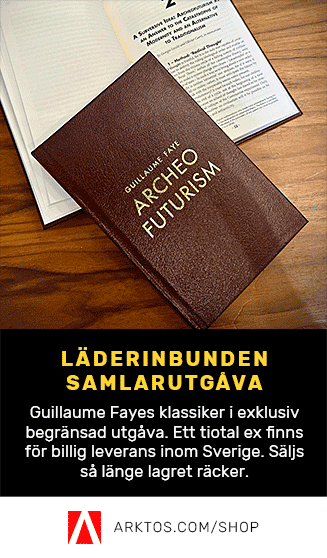Ni som följt min blogg ett tag vet redan att jag är intresserad av den italienske Traditionalisten Julius Evola, och av de indo-ariska myterna. Här kommer därför ett utdrag ur hans magnum opus, Revolt Against the Modern World, där han sammanfattar olika religioners syn på var vi egentligen kommer ifrån:
Allegedly, according to tradition, in an epoch of remote prehistory that corresponds to the Golden Age or Age of Being, the symbolical island or ”polar” land was a real location situated in the Arctic, in the area that today corresponds to the North Pole. This region was inhabited by beings who by virtue of their possession of that nonhuman spirituality (characterized by gold, ”glory”, light and life) that in later times will be evoked by the abovementioned symbolism, founded the race that exemplified the Uranian tradition in a pure state: this race, in turn, was the central and most direct source of the various forms and manifestations this tradition produced in other races and civilizations.
…….
We know that according to an astrophysical cause, that is, to the tilting of the terrestrial axis, in every era there has been a change in climate. According to tradition, this inclination occured at the specific moment in which the syntony of a physical and a metaphysical event occured, as if to represent a state of disorder in the natural world that reflected an event of a spiritual nature. When Lieh-tzu described the myth of the giant Kung-Kung who shatters the ”columns of heaven”, he was probably referring to such an event. In this Chinese tradition we also find other concrete references, such as the following one, though it is mixed together with details that describe later cataclysms:
The pillars of heaven were shattered. The earth shook at its foundations. The northern skies descended lower and lower. The sun, the moon and the stars changed their course [their course appeared changed as a result of the tilting of the terrestrial axis]. The earth’s surface cracked and the waters contained in its belly gushed forward and indundated various countries. Man was in a state of rebellion against Heaven and the universe fell victim to chaos. The sun darkened. The planets changed their course [because of the abovementioned shift in perspective] and the great harmony of heaven was destroyed.
In any event, the freezing and the long night descended at a specific time on the polar region. Thus, when the forced migration from this seat ensued, the first cycle came to an end and a new cycle -the Atlantic cycle- began.
Aryan texts from India, such as the Vedas and the Mahabharata preserve the memory of the Arctic seat through astronomical and calendar-related allusions that cannot be understood other than through an actual reference to such a seat. In the Hindu tradition the term dvipa, which means ”insular continent”, is often used to designate different cycles by virtue of a spatial transposition of a temporal notion (cycle=island). Now, in the doctrine of the dvipa we find meaningful recollections of the Arctic seat, even though they are mixed with other things. The abovementioned Sveta-dvipa (”Island of Splendor”) was situated in the Far North: the Uttara-Kuru are often mentioned as an original Northern race that originated from Jambu-dvipa, the ”polar” insular continent that is the first of the various dvipa and, at the same time, the center of them all. Its memory is mixed with the memory of Saka-dvipa, located in the ”white sea”, or ”milky sea”, namely the Arctic Sea.
…….
Among the Aryans from Iran we find more precise memories. Their original seat (Airyana Vaego) created by the god of light and in which the ”glory” dwells and where the king Yima allegedly met Ahura Mazda, was a land situated in the Far North. The tradition of the Zend-Avesta relates that Yima was warned in advance of the approaching of ”fatal winters” and that the ”serpent of winter”, the pet of the god of darkness, Angra Mainyu, came upon Airyana Vaego; then ”there were ten months of winter and two of summer”, and ”it was cold in the waters, on the earth, and frost covered the vegetation”. Ten months of winter and two months of summer, this is the climate of the Arctic regions.
The Nordic-Scandinavian tradition, notwithstanding its fragmentary nature, offers various testimonies that are often mixed together in a confused way. It is possible however, to find analogous statements. The Asgard, the primordial golden seat pof the Aesir, was located by thosetraditions in the Mitgard, which was the ”Land of the MIddle”. ”This mythical land was in turn identified both with Gardarike, which is a semi-arctic region, and with the ”Green Island” or ”Green Land”, which, though portrayed in ancient cosmology as the first island to arise from the abyss Ginnungagap, is likely to be related with Greenland itself. Greenland, as the name itself suggests, seems to have had a rich vegetation and to have been unaffected by the Ice Age up to the time of the Goths. In the MIddle Ages we still find the idea that the northern regions were the original birthplace of all races and people.
…….”
(Julius Evola, Revolt against the Modern World, p. 188-191)
Evola then goes on to describe similar traditions of the Tibetans and Chinese, Northern Amerinds, Quiche, Gaels, and Graeco-Romans.
Det finns lite mer information om de buddhistiska texterna och de medeltida kartorna, i det här sammanhanget, här:
http://www.eaudrey.com/myth/Places/Mercator%20Article.pdf










